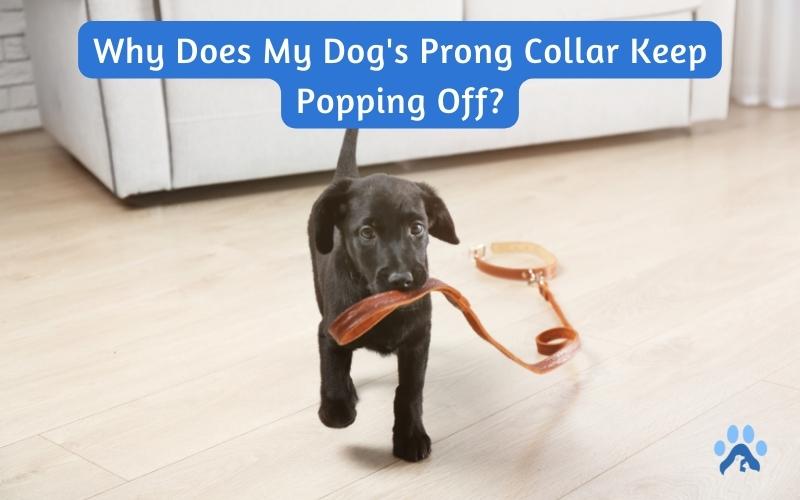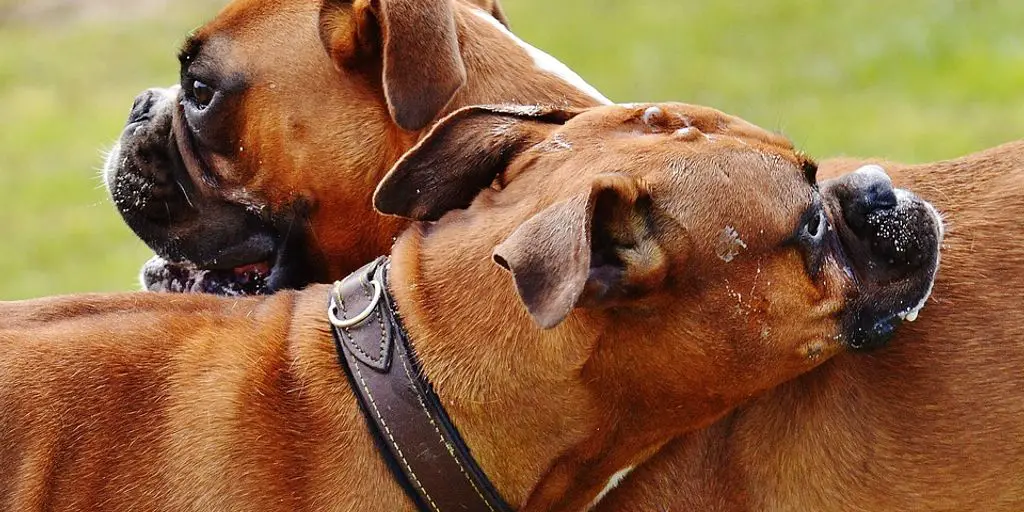If you have a dog wearing a prong collar, you may wonder why it keeps popping off. It can be because either the collar isn’t correctly fitted or you don’t tighten it enough.
Prong collars are a commonly used type of dog collar and can be an effective tool in helping to control the behavior of strong-willed or dog-reactive dogs.
In this blog post, we aim to explore the answers to your query, “Why does my dog’s prong collar keep popping off?” and what you could do to ensure it remains safe.
We will also discuss the importance of properly fitting the collar and tips for avoiding common mistakes when fitting a prong collar on your dog’s neck.
With the correct information and some know-how, you can ensure that your pup’s collar stays securely in place and keep them safe and happy.
Here’s all you need to know,
Why Does My Dog’s Prong Collar Keep Popping Off?
If you’re wondering, “Why does my dog’s prong collar keep popping off?” Various rationales could apply.
- First, the collar might not be set appropriately. If the collar is too loose, it will quickly come off; if it’s too tight, it will be uncomfortable for your dog and may cause choking.
- Another possibility is that your dog’s fur is too thick or long, preventing the prongs from making proper contact. In this case, you may need a longer or broader collar or trim your dog’s fur around the neck area.
- The prongs on the collar may also be too short for your particular dog size, so the collar might always pop off. If that’s the case, the prongs won’t reach deep enough into your dog’s skin to provide the proper correction.
- Finally, some dogs have solid necks and can pull out even well-fitted collars. In this case, you’ll need to train them not to pull on their leash.
How to Fit Prong Collars?
Prong collars are often viewed as a controversial method of training dogs. They could, however, be a very effective tool if used properly.
If you’re considering using a prong collar on your dog, it’s crucial to understand how to fit it correctly.
Here is a step-by-step process for fitting a prong collar:
- Measure your dog’s neck circumference. Prong collars are available in various sizes, so make sure you get one that will fit your dog well.
- Start holding the prong collar in your hand with the points facing down. Unclip the link that connects the two ends of the collar.
- Place the collar around your dog’s neck. The collar should sit high on the neck, just behind the ears. Allow room for the prongs to move around, so they don’t damage your dog’s skin.
- Once the collar is in place, reattach the link connecting the collar’s two ends. Make sure the attachment is strong enough to prevent it from being dragged through the collar’s end hole.
- Fasten the prongs, and finally, attach your leash to the ring on the end of the prong collar.
- Start with short walks around your house or yard, and gradually increase the length of your walks. You don’t want them to be painful or choke your dog, but you want them to feel pressure from the prongs while wearing the collar.
- Finally, practice using the leash and giving commands while your dog is wearing the collar. This will help them get used to feeling the pressure from the prongs and make training with the collar easier for both of you.
Prong Collars Usage – When to Use and How to Use?
Prong collars, also known as pinch collars, can be helpful when training your dog. They can provide an effective and humane way to correct unwanted behaviors when used correctly.
However, it is essential to know that prong collars should only be used for training purposes, not everyday wear. Plus, they should be used as a last resort after other forms of training have failed.
Prong collars should not be used for long periods or when the dog is overly excited or aroused. It should only be used when your pup is already in a calm state.
Also, don’t forget to tighten the collar just enough to press slightly into the dog’s neck when pulling, but it should be removed immediately afterward.
In addition, it is essential to be consistent and patient in using the collar and providing positive reinforcement.
Do Prong Collars Loosen With Use?
Prong collars are a controversial training tool used to train dogs. They are designed to deliver a corrective stimulus when the dog pulls on the leash and are popular among professional trainers.
The question then becomes, do prong collars loosen with use? After extensive research, the answer appears to be yes.
Prong collars are designed with slightly bent links so that when the leash is pulled, the collar tightens, but when the tension is released, the links can move, and the collar can loosen.
This means that if the leash is consistently used for long periods, the prong collar may loosen and require adjustment.
While prong collars can be practical tools for training, it is essential to monitor their wear and tear and ensure they are regularly adjusted.
How Long Should Dogs Wear Prong Collars?
Most trainers recommend that dogs wear prong collars for 15 minutes at a time and no more than 4 hours per day.
However, be sure to monitor their behavior closely to ensure they don’t become overstimulated or stressed while wearing the collar. The collar should be removed immediately if dogs are uncomfortable or appear distressed.
It is also important to discontinue the collar when the dog no longer needs it or responds to its curative effects.
Conclusion
So, why does my dog’s prong collar keep popping off? We hope you’ve already got the answers.
Several factors, including an incorrect fit, insufficient tightness, or a malfunctioning or defective collar, can cause this issue.
Therefore, it is essential to ensure that the collar is the proper size and is fitted correctly.
The popping off of a prong collar can be a nuisance and potentially dangerous if a dog is not adequately secured, especially if the dog is off-leash.
If the “popping-off” problem persists, it is advised to take the collar to a professional for inspection, as it may signify a more significant problem.
Frequently Asked Questions
How do I keep my prong collar from slipping?
First, ensure the collar is the correct size for your dog’s neck. It will be simple to remove if it is too slack.
Also, ensure that the collar is fastened securely with the correct tension. The collar should be snug when attached but not too tight or loose.
To further secure the collar, try adjusting it, so the prongs curve down and back towards the dog’s neck.
Additionally, use a backup collar such as a buckle or martingale to keep the prong collar in place.
Regularly watch the collar for signs of deterioration and change it if necessary.
Should a prong collar be tight or loose?
Prong collars should be tailored to the individual dog, depending on the breed and size of the dog. It should be snug enough that it won’t slip over the dog’s head yet loose enough to allow two fingers to fit between the collar and the neck.
Keeping the prong collar snug helps prevent the dog from backing out of it and allows the collar to activate more quickly when it pulls.
It is essential to monitor your dog’s comfort level when wearing a prong collar, as a collar that is too tight can cause skin irritation or even injury.
Do prong collars come off?
Yes, prong collars are designed to be adjustable and easily removable. The collar has two parts, the prongs, and the buckle.
The prongs are connected to the buckle and can be adjusted to fit the size of the dog’s neck. The clip can also be undone to remove the collar.
What does Cesar Millan say about prong collars?
Cesar Millan is an advocate of positive reinforcement and discourages the use of prong collars. He believes this type of collar can cause more harm than good, as it can cause physical pain to the dog.
He suggests that an owner should focus on proper communication and management rather than using a prong collar.
Millan believes that while prong collars can be effective in certain situations, they should only be used as a last resort after other methods have been exhausted.
Where should a prong collar pin be placed?
It is crucial to ensure the pin is positioned correctly when wearing a prong collar. The hook should be placed directly behind the dog’s ears at the top of his neck.
This ensures that the collar is evenly distributed around the dog’s neck and secure. It should also be tight enough that the prongs are close to the skin but not tight enough to cause discomfort.
The prong collar may be too loose and insecure if the pin is too low on the neck. Additionally, the hook should never be set too high, as this can pressure the dog’s trachea.



